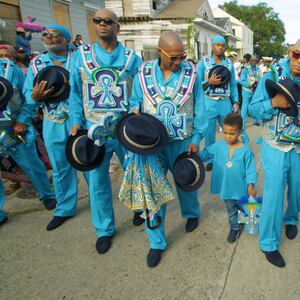The ideal of life lived well lit up the New Orleans night Feb. 5 when the Intergalactic Krewe of Chewbacchus, a walking club of 2,235 members, bedecked in costumes depicting creatures from Star Wars, deceased movie stars, dragons, zombies, Vikings from space, alien aerialists, figures from sci-fi and fantasy worlds, a retinue of over 100 Wonder Women, brass bands, and women aglitter in spinning hoops all paraded from the downtown Bywater neighborhood into the French Quarter, giving bohemia an emergent brand in the city where jazz began.
As leader of the Leijorettes, Brooke Ethridge, a nonprofit administrator by day and by night a Chewbacchus Overlord in the persona of Princess Leia Organa (of the Empire’s Rebel Alliance), sashayed along in a white turtleneck dress, white boots, and heel taps. She led five dozen members, each decked out as Princess Leia, including long-ago Saints lineman Chuck Commiskey, everyone rocking to Whitney Houston’s “I Want to Feel the Heat with Somebody,” among other sizzlers on a loop.
“Getting love on a Saturday night has great resonance when you’re dancing with friends you’ve had for a decade, or brand-new friends,” Ethridge told The Daily Beast. “There are so many sub-krewes within Chewbacchus in memorable costumes. I love the Women of Wakanda, who represent the intersection of Black culture and futurism.”
ADVERTISEMENT
Parading is the heartbeat of New Orleans; the themes, costumes, and sometimes raucous satire of certain krewes, as parade organizations are called, pump the city with revelry, and in survival-against-the-odds times like this, a sense of higher purpose.
Since the massive Hurricane Katrina damage in 2005, the number of street-dancing groups has mushroomed. Some parade in formation with the big-ticket krewes like Rex, Zulu, Muses, and Bacchus, which have lavish floats pulled by tractors with maskers throwing beads and trinkets. The big parades include high-school and college marching bands, and majorettes.
Among the handful or so of foot parades, Chewbacchus is distinctive in its pop culture pageantry and floats, including several made by set artists in the local film industry who put in nights and weekends working on these passion projects. Chewbacchus costs $42 for longtime members; anyone can join, though the price rises in increments to $100 on the day of the parade. The krewe, which began in 2011 with about 300 members, is now the largest walking parade, riding a growth surge to “save the galaxy, one drunken nerd at a time.” The krewe’s core values are inclusivity, green parading, and artistry—all throws and contraptions (small floats) are hand-made by members.

Because of the coronavirus shutdown, it has been nearly two years since parades rolled here. During that time, this city held together by identity pageants has been starved of spectacle. Carnival season starts on Jan. 6 with balls and parades that climax on Mardi Gras, or Fat Tuesday, which falls on March 1 this year. The last five days are a major blow-out.
An editorial in Gambit, the alternative weekly, warned of overreach:
“We remind one and all to indulge responsibly by offering our annual list of the top ways to get arrested.”
<p>* Don’t pee in public. You WILL be arrested and spend up to a week in jail.* Don’t insult or mouth off to cops and don’t mess with cops’ mounted horses.* Don’t jump on a parade float. You will go to jail, and not just overnight.</p>
Krewe du Vieux, founded in 1987, is an ancestral force of the walking parades, known for its army of top brass bands and scalding political satire. The most memorable float, several years ago, featured a replica of then-Gov. Bobby Jindal with an enormous procreative organ, thrusting into the butt of an outsize pelican, the official state bird.
Krewe du Vieux’s theme this year was “Vaxxed and Confused.” The Feb. 12 parade featured an unflattering effigy of Mayor LaToya Cantrell as an octopus reaching over the city, which in real time has been straining to collect garbage since Hurricane Ida crashed down on Aug. 29. Another group paraded as flies buzzing and partying around a large dumpster float, which featured the tail of a dead alligator hanging out of it—a reference to the real alligator that was found wrapped in a blue tarp and decomposing half-in, half-out of a bright pink dumpster after Hurricane Ida.

Krewe du Vieux traditionally chooses a local celebrity as monarch—bluesman Walter “Wolfman” Washington and author John Barry were past kings. This year’s choice as queen, Dr. Jennifer Avegno, is the city health director who guided Mayor LaToya Cantrell’s masking and shelter in place policy. Avegno, however, withdrew from riding the royal float several days before the parade because of death threats.
At the krewe ball in The Sugar Mill, a Warehouse District venue, Dr. Avegno drew cheers when she said, “You guys have restored my faith in humanity.”
Avegno’s reluctance to ride on the lead float was one more sign of the bitter anti-science fervor generated in some corners of the city by pandemic policy. New Orleans has a vaccination rate of 79 percent, while a 52 percent vaccination rate prevails in a state Trump carried in 2020 with 58 percent of the vote.
The city still has a mask mandate in place for indoor spaces. But as crowds, mostly unmasked, head to parades, the viral impact is an open question. Democracy’s bipolar nature down here is on full display across Lake Pontchartrain, some 30 miles from the city in Mandeville, in the red stronghold of St. Tammany Parish. Shop in supermarkets there and see the freedom lovers glare at you for wearing a mask. At least they keep their shirts on.

Like many cities, New Orleans is reeling from a surge in crime. A brazen spate of car-jackings and rising gun homicides have thrown a spotlight on a police force so short-staffed that City Hall is offering signing bonuses to bulk up NOPD.
“A friend of mine got into an accident with a drunk driver at 8 a.m.—on her way to work,” a woman posted on Facebook recently. “The cops didn’t show up for 3 hours, by which time the driver had fallen asleep twice AND left the scene.”
As bad as times are in this city of 384,000, with some side streets and even parts of thoroughfares bearing crevices from subsidence as the Mississippi River oozes beneath the soil, the pleasure-loving populace showcases pluck against the odds. Carnival season brings back a sense of life as it should be.
“These past two years have been colored by an absence of joyousness for me and lots of other people,” says Aryanna Gamble, one of two other Chewbacchus Overlords, who rode her trike in the parade this year dressed as a rainbow Mandalorian (a colorful play on the race of Outer Rim warriors in the Star Wars universe), the iconic gold and silver helmet covered in glowing neon streaks and her armor festooned with rainbow fur accessories.
Gamble, whose mom is from Guatemala and dad from Tennessee, recalls "watching the big parade krewes on St. Charles Avenue as a child. I never envisioned myself as being wealthy or well connected enough to be part of those traditions. One of the core tenets of Chewbacchus is radical inclusivity—the idea that you don’t have to be rich to be part of Carnival.”
“I still get choked up thinking about the emptiness on what would have been our parade day in 2021,” she continues, with a catch in her throat.
“Living here, you can sometimes take for granted what Carnival means. On the surface it may look like parties, but when you get into making costumes for a krewe and marching, it’s real meaning-of-life stuff. My husband, brother, sister, and nieces and my best friends are in Chewbacchus with me, getting together in living rooms, dens, and garages, making art that we’re going to give away. Rolling on Saturday night, after two years without that bonding time, I felt like, finally, my cup was full. I will never take that for granted again.”







